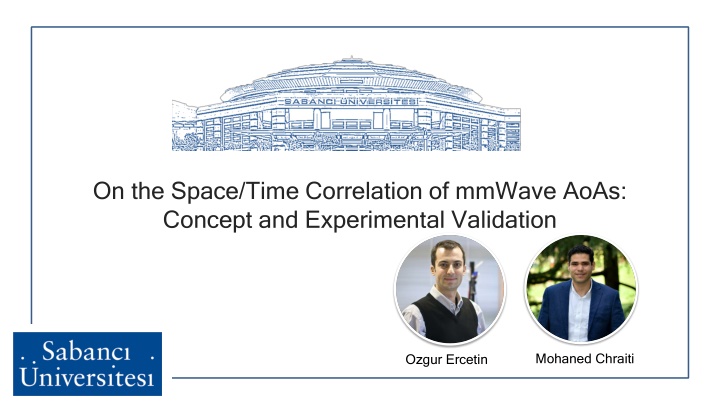
Space-Time Correlation of mmWave AoAs: Concept & Experimental Validation
Explore the concept and experimental validation of space-time correlation of mmWave Angle of Arrivals (AoAs). The study delves into coherence time, channel equalization, and beamforming implications in free-space transmissions. Sparse vs. rich scattering scenarios are examined, along with conjunctures impacting beamforming strategies. Discover the implications for statistical-based beamforming, fingerprinting techniques, and more in the realm of mmWave/Terahertz communications.
Download Presentation

Please find below an Image/Link to download the presentation.
The content on the website is provided AS IS for your information and personal use only. It may not be sold, licensed, or shared on other websites without obtaining consent from the author. If you encounter any issues during the download, it is possible that the publisher has removed the file from their server.
You are allowed to download the files provided on this website for personal or commercial use, subject to the condition that they are used lawfully. All files are the property of their respective owners.
The content on the website is provided AS IS for your information and personal use only. It may not be sold, licensed, or shared on other websites without obtaining consent from the author.
E N D
Presentation Transcript
On the Space/Time Correlation of mmWave AoAs: Concept and Experimental Validation Mohaned Chraiti Ozgur Ercetin
Outline Results Conjunctures Coherence Time Impact of rich scattering Implications Experimental set up Coherence space Correlation function Definition Beam coherence time vs channel coherence time 2
Coherence Time Definition Channel equalization Error probability Channel estimate is almost time invariant Channel CT Beam CT Beam and width direction estimate are almost time invariant Beam steering vector Received power 3
Coherence Time CCT vs BCT: the case of free space transmissions (single ray) 0 0 Channel coherence time The phase of the received signal varies as the user moves 1GHz 1GHz 30 GHz => 30 30 GHz => 30 phase variation rate ? ? ? phase variation rate ? ? ? CCT CCT = ??? 0 0 Beam coherence time The bam direction is almost time invariant Beam coherence time >> channel coherence time ? that is in the order of mm of mm ? that is in the order 4
Conjunctures Sparse vs rich scattering 1= ??1,????1,? 1= ???1 d d 2= ???2 2= ??2,????2,? mmWave/Terahertz (conjunctures): 1) 1 2 ,?1 ?2 for ? >? ???????? ???? ???? ????????? ???? ?????? 2) 1 2 ??? ?1 ?2 for ? >? Sub-6GHz: 1 2 and ?1 ?2 for ? >? ??? = ??? and and AoAs AoAs are uniformly distributed 2 ??? ???? ??? ???? 2 are uniformly distributed 5 2 ??? ???
Conjuncture Implications Beamforming Statistical based beamforming: Pr( ) is non uniformly distributed in given environment (conjuncture 1) [6] Fingerprinting techniques (conjuncture 2) [5] Low beam tracking overhead ( channel tracking) Beam steering vector may not change independently form one CCT to another (conjuncture 2) Distributed massive MIMO (conjuncture 1 & 2) Others works Radio resource allocation often require SNR estimate Multiplexing (conjuncture 2) 6
Results Harsh propagation environment: Indoor office environment Measuremnet point: - 10? horn antenna mounted on a rotating platform - Full scan 400 ms mounted - 1? precision - 700 measurement point Experimental vs ray tracing Two ray model does not match the experimental results [10]=> five ray's model model five ray's Horn antenna: 55? half-power beamwidth Preliminary results: radiation pattern at two close locations 30cm 5 m 118 m Dynamic environment: moving obstacles 7
Results AoAs statistics inference Objecticve Infer a statistical model about the AoAs: repetitive structure AoAs correlation as a function of crossed distance Bayesian learning Beam coh. distance ? |?1,?2 = ?(?? | ?)?0 ?(?? | ??)?0d ? Gibs sampling Constraint: Kullback divergence Correlation between beam pattern as functionof the crossed distance. Model Multi-variate Gaussian ?dB optimal ray and ?correlated. Challenge Non-parametric inference 8
Results Conjuncture 1 AoAs are not uniformly distributed The results differs from the existing belief of uni-modal dsirobution [6] The distribution may differ from one environment to another 9
Results Conjuncture 2 BCT CCT The correlation is probabilistic in nature. 10
